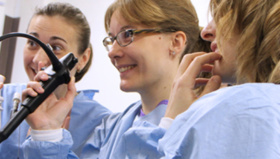Adopting Aviation Industry Standards for Hospital Surgical Departments Is Long Overdue
Robotic Surgery has been around for over 15 years in most U.S. health care systems. The introduction of computer-assisted robotic surgery has enabled many surgeons of all different specialties to perform minimally invasive procedures on more patients than ever before. But like all new technologies, there have been both good and bad outcomes. The good has been better surgical outcomes with faster recoveries. The bad, however, has been higher costs, more injuries and lawsuits. Robotic surgery has been labeled an “enabling technology” and while this is true overall, as with many other new technologies, problems have occurred.

The negative issues with robotic surgeries fall primarily into two categories:
1. Increased direct costs
2. Increased surgical injuries
These issues can be related to multiple factors, but one of the primary causes of both problems is surgeon inexperience with the robot (surgeons still in their learning curve or surgeons who use the robot infrequently for only their “hardest” cases) and surgeons trying to tackle more difficult and challenging cases than they would normally because of the confidence that having the robot confers. Many hospital medical staff committees have struggled with how to deal with these issues for the last decade. But there is an easy answer: simulation.
Use of simulation in the aviation industry has made it a highly safe and reliable industry as a whole. The chance of a catastrophic pilot error is significantly less than the same risk related to a surgical error. Part of the reason for this is that commercial pilots train and continue to train their entire careers using simulation to practice normal as well as unusual flying conditions.

Implementing a similar training/practice protocol for surgeons would, it seems, bring similar positive outcomes for patient safety during computer assisted robotic surgery. Doesn’t patient safety warrant this level of preparation?
The AAGL (The world’s foremost Minimally Invasive Gynecologic Surgical Society) has recommended that all robotic surgeons not only do their initial training on simulators prior to operating on human patients, but that they also continue to practice between surgeries especially if they don’t operate frequently using the robot.
The AAGL has also recommended that all surgeons demonstrate proficiency in operating a robot by successfully completing a series of simulation exercises every year (AAGL Guidelines: Guidelines for Privileging for Robotic-Assisted Gynecologic Laparoscopy. J Minim Invasiv Gynecol, 21(2), Mar-Apr 2014.). These simulation exercises can be accomplished on the robotic platform itself with a connected simulator, however, it is more convenient and useful to do these on independent free-standing simulators allowing for more access for surgeons to practice and ensuring the robot can be used for its intended purpose in the operating room. The airline industry figured this out long ago, keeping its fleets of planes constantly in the air while simulation is accomplished at separate simulation training facilities.
The AAGL annual simulation requirements can be found in their Robotic Surgery Guidelines document. By instituting guidelines for local hospitals, both academic and community based, can be assured that their surgeons are competent to operate the robot proficiently, even if they have “low volume” surgeons. With more practice, operating efficiency will increase and surgical errors should diminish. This is a “win-win” and adopting aviation industry standards for hospital surgical departments is long overdue. Our patients expect and deserve this.
Author: John Lenihan Jr., MD, FACOG
References:
- Advincula A., Arora C., Lenihan Jr. JP. “2017 Update on Minimally Invasive Gynecologic Surgery.” OBG Manag. 2017 November; 29(11): 38-39, 42-46. (Simulation’s Role in GYN Surgery Training, How to Incorporate Simulation into Credentialing and Privileging).
- Lenihan JP. Navigating Credentialing and Privileging and Learning Curves in Robotics with an Evidence and Experienced Based Approach. Clin Obstet Gynecol. 2011, 54(3), 382-390.
- AAGL Guidelines: Guidelines for Privileging for Robotic-Assisted Gynecologic Laparoscopy. J Minim Invasiv Gynecol, 21(2), Mar-Apr 2014.













